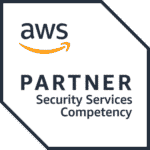Your partner for AWS security architecture
An AWS cloud is a powerful tool – but that just makes security all the more important. You don’t need to worry: Our AWS cloud security experts have expertise in technical implementation, compliance, data protection, and all-round security.
With security always at the forefront of our minds, we build robust and scalable AWS architectures. Our close relationship with AWS means we are always informed on the latest developments and tools, meaning we can also support clients in strictly regulated industries with highly sensitive data.
 Our experience with cloud migrations and AWS dates back more than a decade – we were even awarded the status of AWS Advanced Consulting Partner back in 2014. In the time since, we’ve completed many successful projects in a wide range of sectors, including highly regulated industries. We have also continued to enhance our standardized approach to application migration, resulting in established AWS best practices and AWS security architectures – both regularly augmented with our own specialist security expertise.
Our experience with cloud migrations and AWS dates back more than a decade – we were even awarded the status of AWS Advanced Consulting Partner back in 2014. In the time since, we’ve completed many successful projects in a wide range of sectors, including highly regulated industries. We have also continued to enhance our standardized approach to application migration, resulting in established AWS best practices and AWS security architectures – both regularly augmented with our own specialist security expertise.
Clients demand agility and performance while meeting every applicable security and compliance standard – and we deliver. We apply a tried-and-tested model that can be trusted to reliably tick every box.
Skaylink is with you for the journey – from testing and validating your first use case to managing your ongoing cloud operations and establishing robust compliance and security checks for every conceivable scenario.
Skaylink’s AWS security best practices
Scalable and carefully monitored AWS account infrastructure that maps security and regulatory requirements.
Service catalogs that provide centrally security-tested templates for application designs, network architectures, and infrastructure services.
Automatic provisioning of an isolated application landscape for each service.
A framework applies compliance checks to continuously validate every aspect of the AWS infrastructure based on proven AWS best practices, the latest industry standards, and established benchmarks. Results are shared and reported through a central compliance dashboard.
Automatic provisioning of centralized infrastructure components, such as AWS Key Management Service (KMS) infrastructure, AWS Identity and Access Management (IAM), log management, storage, and evaluation of AWS CloudTrail and AWS Config.
Proprietary and low-maintenance solutions that address known security requirements where there is no existing AWS service to perform the same task,e.g. URL filtering of outbound network traffic.
Okta: The best identity solution for your AWS cloud
An identity solution is critical to the security and integrity of an organization’s IT infrastructure. It offers centralized management and control of access rights and identities of users, applications, and devices. Without such a solution, organizations are exposed to various security risks and attacks.
Downloadable guides
Accelerated Control Tower Framework
This one-page overview tells you everything you need to know about our 3-day workshop for setting up the AWS Control Tower.
Sustainable AWS landing zone
We will train your staff and you will receive comprehensive documentation regarding the entire setup.
Evaluating the security posture of your AWS environment with the AWS security assessment
The AWS Security Assessment covers data protection, infrastructure, identity and access management, event detection, and incident response.
Case Stories

AWS control tower – secure multi-account setup at the push of a button

How Six Offene Systeme got started in the AWS cloud
Contact
Make your cloud a fortress with Skaylink
In a time where cyberthreats and data leaks regularly make national headlines, you’d better do your best to lock your digital doors.
Even the most physically capable security personnel appreciate the help of digital tools and added people power – the cyber world is no different.
Let’s make the hard task of AWS security and compliance that little bit easier.
Speak to our AWS security experts today